Maternal Anaemia in India: A Case Study of Maternal Mortality
VerifiedAdded on 2023/03/30
|23
|5352
|77
Report
AI Summary
This research proposal examines the issue of maternal anaemia in India, a significant public health concern. The study investigates the prevalence, causes, and consequences of anaemia among pregnant women, with a particular focus on the situation in urban areas. The research delves into the factors contributing to maternal mortality, including poor sanitation, inadequate nutrition, and social inequalities. The proposal outlines a qualitative research design employing a phenomenological framework to explore the perceptions, attitudes, and experiences of affected women. Data collection methods will include in-depth interviews to gain insights into the challenges faced by pregnant women. The study aims to identify gaps in existing research, address the need for targeted interventions, and propose solutions to reduce the incidence of maternal anaemia and improve maternal health outcomes in India. The study also acknowledges the limitations and ethical considerations associated with this research.
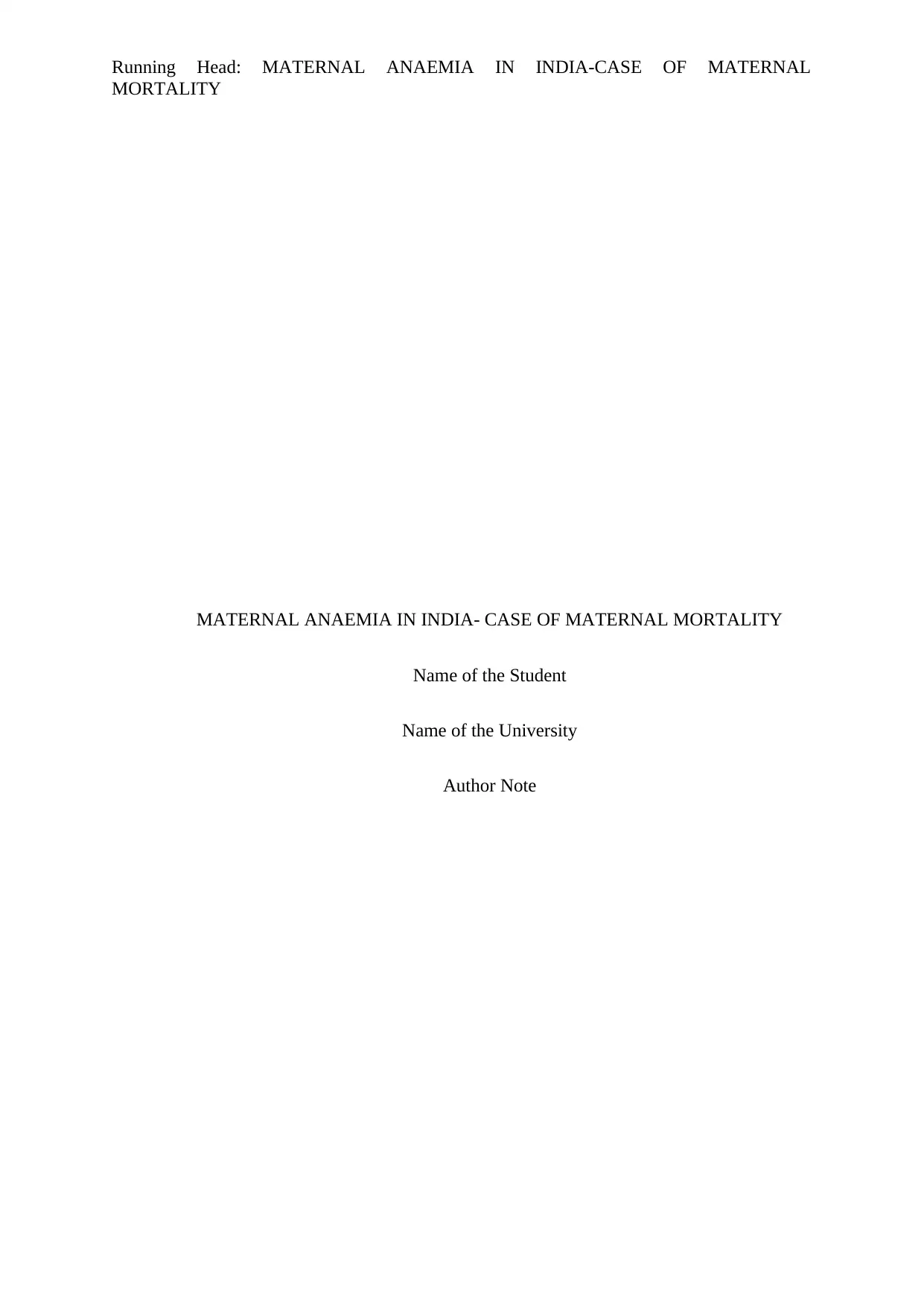
Running Head: MATERNAL ANAEMIA IN INDIA-CASE OF MATERNAL
MORTALITY
MATERNAL ANAEMIA IN INDIA- CASE OF MATERNAL MORTALITY
Name of the Student
Name of the University
Author Note
MORTALITY
MATERNAL ANAEMIA IN INDIA- CASE OF MATERNAL MORTALITY
Name of the Student
Name of the University
Author Note
Paraphrase This Document
Need a fresh take? Get an instant paraphrase of this document with our AI Paraphraser
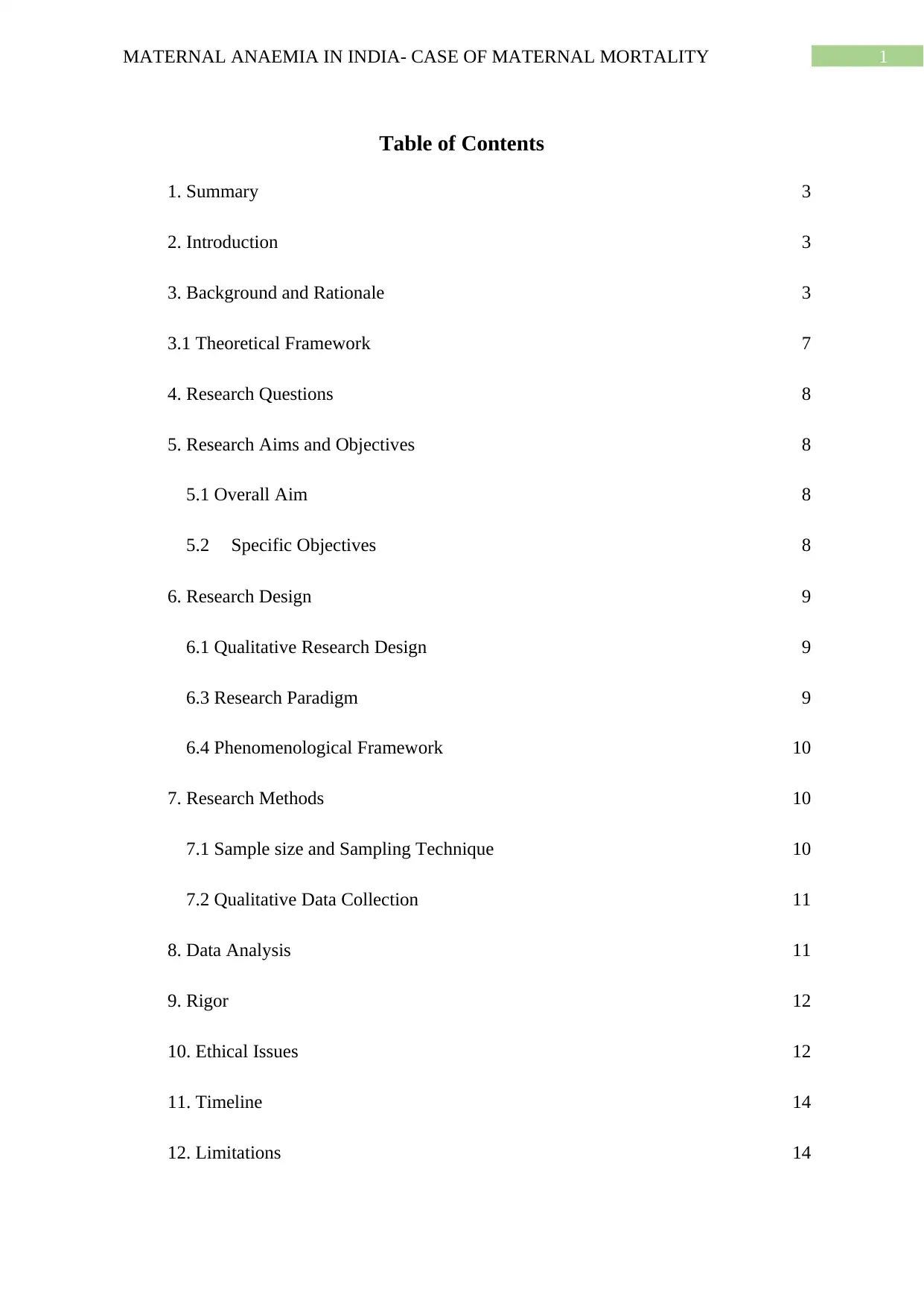
1MATERNAL ANAEMIA IN INDIA- CASE OF MATERNAL MORTALITY
Table of Contents
1. Summary 3
2. Introduction 3
3. Background and Rationale 3
3.1 Theoretical Framework 7
4. Research Questions 8
5. Research Aims and Objectives 8
5.1 Overall Aim 8
5.2 Specific Objectives 8
6. Research Design 9
6.1 Qualitative Research Design 9
6.3 Research Paradigm 9
6.4 Phenomenological Framework 10
7. Research Methods 10
7.1 Sample size and Sampling Technique 10
7.2 Qualitative Data Collection 11
8. Data Analysis 11
9. Rigor 12
10. Ethical Issues 12
11. Timeline 14
12. Limitations 14
Table of Contents
1. Summary 3
2. Introduction 3
3. Background and Rationale 3
3.1 Theoretical Framework 7
4. Research Questions 8
5. Research Aims and Objectives 8
5.1 Overall Aim 8
5.2 Specific Objectives 8
6. Research Design 9
6.1 Qualitative Research Design 9
6.3 Research Paradigm 9
6.4 Phenomenological Framework 10
7. Research Methods 10
7.1 Sample size and Sampling Technique 10
7.2 Qualitative Data Collection 11
8. Data Analysis 11
9. Rigor 12
10. Ethical Issues 12
11. Timeline 14
12. Limitations 14
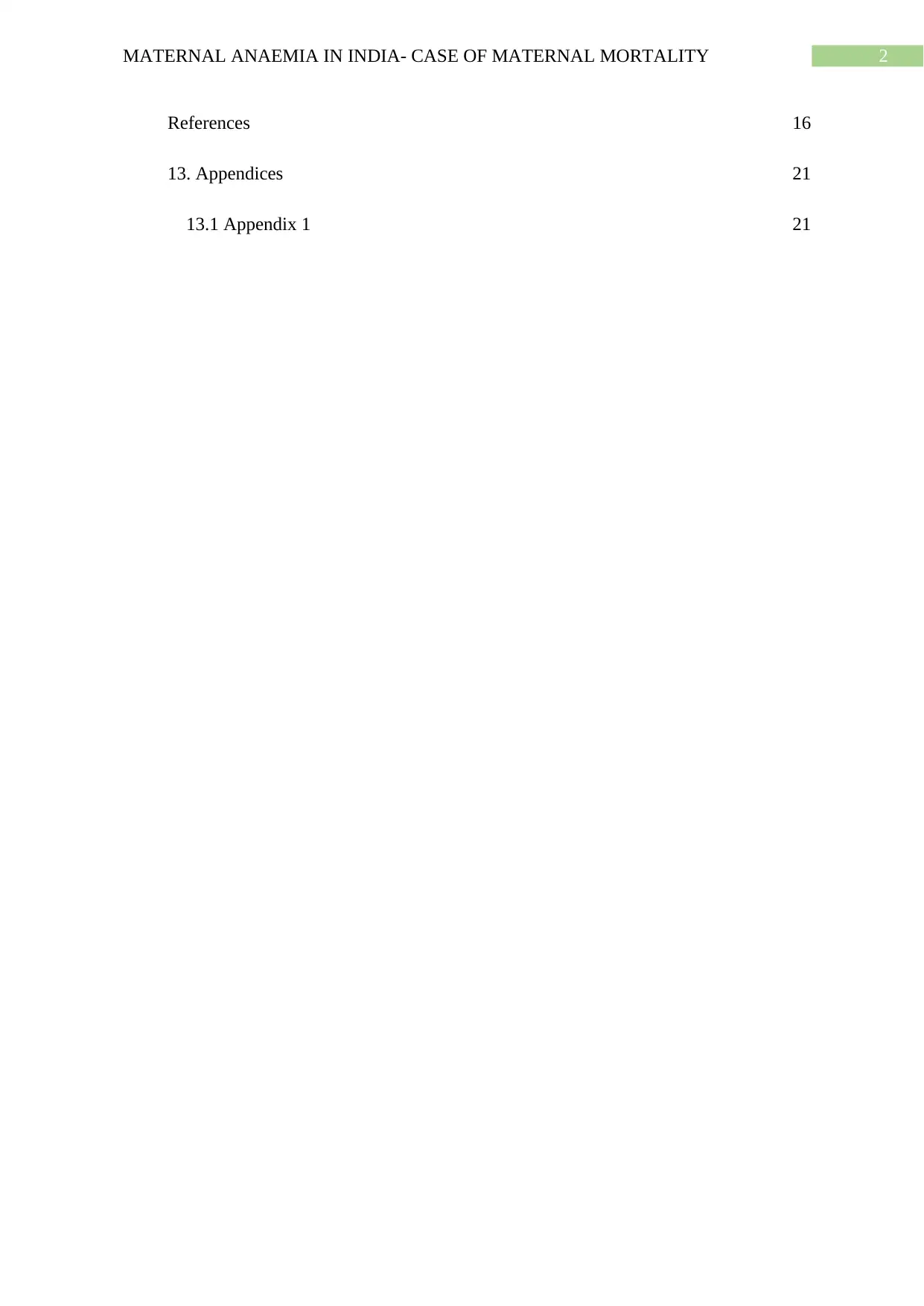
2MATERNAL ANAEMIA IN INDIA- CASE OF MATERNAL MORTALITY
References 16
13. Appendices 21
13.1 Appendix 1 21
References 16
13. Appendices 21
13.1 Appendix 1 21
⊘ This is a preview!⊘
Do you want full access?
Subscribe today to unlock all pages.

Trusted by 1+ million students worldwide
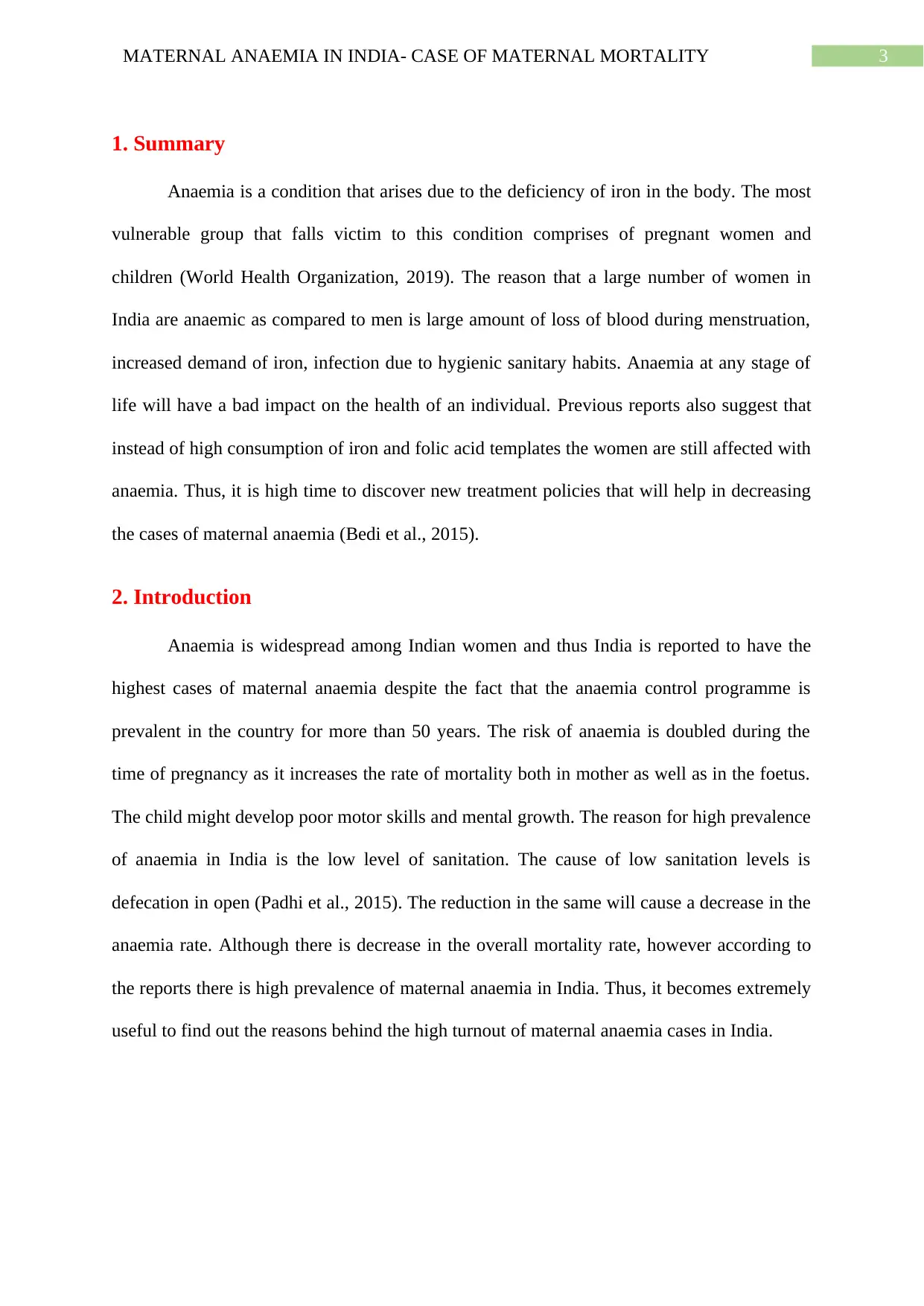
3MATERNAL ANAEMIA IN INDIA- CASE OF MATERNAL MORTALITY
1. Summary
Anaemia is a condition that arises due to the deficiency of iron in the body. The most
vulnerable group that falls victim to this condition comprises of pregnant women and
children (World Health Organization, 2019). The reason that a large number of women in
India are anaemic as compared to men is large amount of loss of blood during menstruation,
increased demand of iron, infection due to hygienic sanitary habits. Anaemia at any stage of
life will have a bad impact on the health of an individual. Previous reports also suggest that
instead of high consumption of iron and folic acid templates the women are still affected with
anaemia. Thus, it is high time to discover new treatment policies that will help in decreasing
the cases of maternal anaemia (Bedi et al., 2015).
2. Introduction
Anaemia is widespread among Indian women and thus India is reported to have the
highest cases of maternal anaemia despite the fact that the anaemia control programme is
prevalent in the country for more than 50 years. The risk of anaemia is doubled during the
time of pregnancy as it increases the rate of mortality both in mother as well as in the foetus.
The child might develop poor motor skills and mental growth. The reason for high prevalence
of anaemia in India is the low level of sanitation. The cause of low sanitation levels is
defecation in open (Padhi et al., 2015). The reduction in the same will cause a decrease in the
anaemia rate. Although there is decrease in the overall mortality rate, however according to
the reports there is high prevalence of maternal anaemia in India. Thus, it becomes extremely
useful to find out the reasons behind the high turnout of maternal anaemia cases in India.
1. Summary
Anaemia is a condition that arises due to the deficiency of iron in the body. The most
vulnerable group that falls victim to this condition comprises of pregnant women and
children (World Health Organization, 2019). The reason that a large number of women in
India are anaemic as compared to men is large amount of loss of blood during menstruation,
increased demand of iron, infection due to hygienic sanitary habits. Anaemia at any stage of
life will have a bad impact on the health of an individual. Previous reports also suggest that
instead of high consumption of iron and folic acid templates the women are still affected with
anaemia. Thus, it is high time to discover new treatment policies that will help in decreasing
the cases of maternal anaemia (Bedi et al., 2015).
2. Introduction
Anaemia is widespread among Indian women and thus India is reported to have the
highest cases of maternal anaemia despite the fact that the anaemia control programme is
prevalent in the country for more than 50 years. The risk of anaemia is doubled during the
time of pregnancy as it increases the rate of mortality both in mother as well as in the foetus.
The child might develop poor motor skills and mental growth. The reason for high prevalence
of anaemia in India is the low level of sanitation. The cause of low sanitation levels is
defecation in open (Padhi et al., 2015). The reduction in the same will cause a decrease in the
anaemia rate. Although there is decrease in the overall mortality rate, however according to
the reports there is high prevalence of maternal anaemia in India. Thus, it becomes extremely
useful to find out the reasons behind the high turnout of maternal anaemia cases in India.
Paraphrase This Document
Need a fresh take? Get an instant paraphrase of this document with our AI Paraphraser
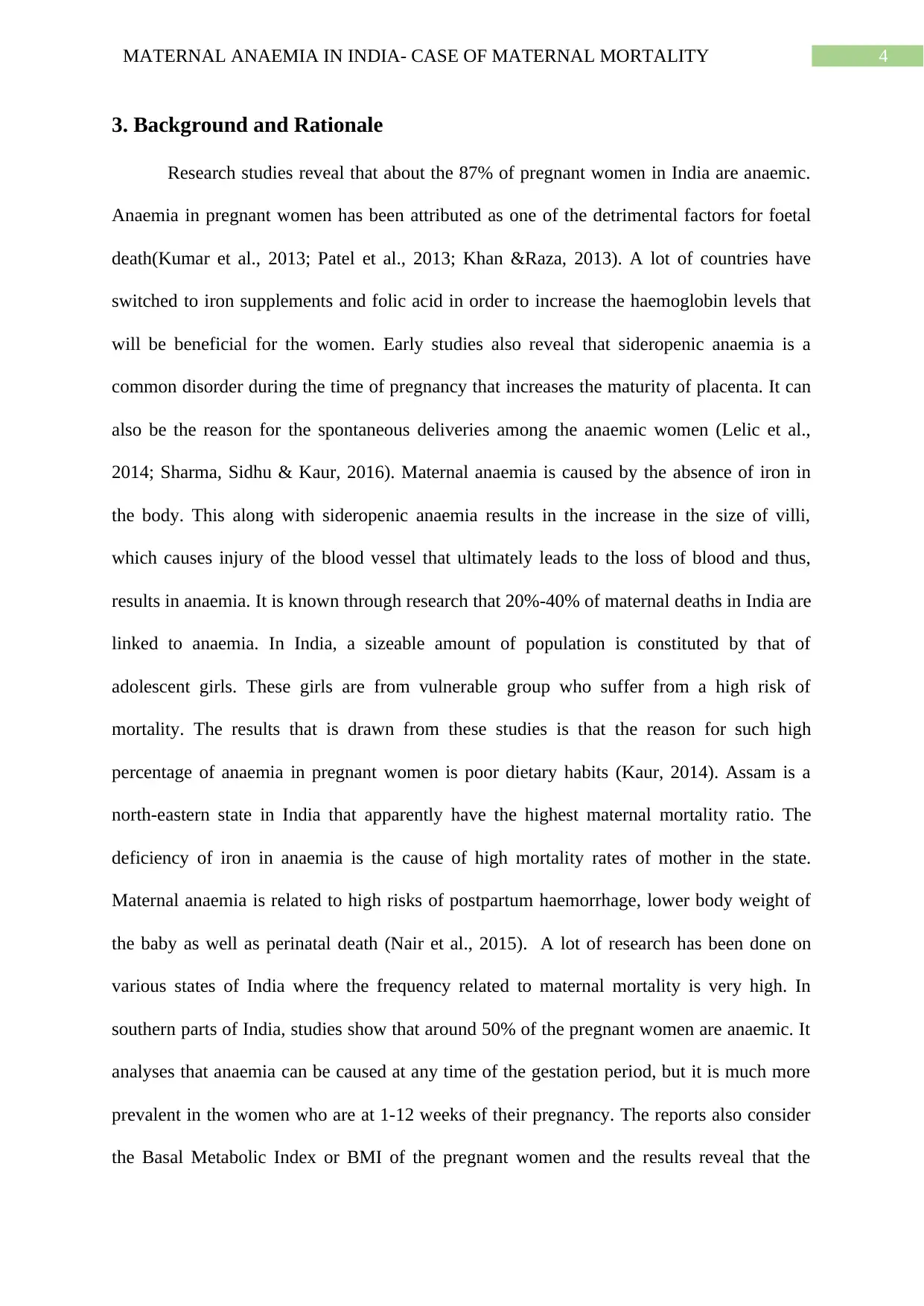
4MATERNAL ANAEMIA IN INDIA- CASE OF MATERNAL MORTALITY
3. Background and Rationale
Research studies reveal that about the 87% of pregnant women in India are anaemic.
Anaemia in pregnant women has been attributed as one of the detrimental factors for foetal
death(Kumar et al., 2013; Patel et al., 2013; Khan &Raza, 2013). A lot of countries have
switched to iron supplements and folic acid in order to increase the haemoglobin levels that
will be beneficial for the women. Early studies also reveal that sideropenic anaemia is a
common disorder during the time of pregnancy that increases the maturity of placenta. It can
also be the reason for the spontaneous deliveries among the anaemic women (Lelic et al.,
2014; Sharma, Sidhu & Kaur, 2016). Maternal anaemia is caused by the absence of iron in
the body. This along with sideropenic anaemia results in the increase in the size of villi,
which causes injury of the blood vessel that ultimately leads to the loss of blood and thus,
results in anaemia. It is known through research that 20%-40% of maternal deaths in India are
linked to anaemia. In India, a sizeable amount of population is constituted by that of
adolescent girls. These girls are from vulnerable group who suffer from a high risk of
mortality. The results that is drawn from these studies is that the reason for such high
percentage of anaemia in pregnant women is poor dietary habits (Kaur, 2014). Assam is a
north-eastern state in India that apparently have the highest maternal mortality ratio. The
deficiency of iron in anaemia is the cause of high mortality rates of mother in the state.
Maternal anaemia is related to high risks of postpartum haemorrhage, lower body weight of
the baby as well as perinatal death (Nair et al., 2015). A lot of research has been done on
various states of India where the frequency related to maternal mortality is very high. In
southern parts of India, studies show that around 50% of the pregnant women are anaemic. It
analyses that anaemia can be caused at any time of the gestation period, but it is much more
prevalent in the women who are at 1-12 weeks of their pregnancy. The reports also consider
the Basal Metabolic Index or BMI of the pregnant women and the results reveal that the
3. Background and Rationale
Research studies reveal that about the 87% of pregnant women in India are anaemic.
Anaemia in pregnant women has been attributed as one of the detrimental factors for foetal
death(Kumar et al., 2013; Patel et al., 2013; Khan &Raza, 2013). A lot of countries have
switched to iron supplements and folic acid in order to increase the haemoglobin levels that
will be beneficial for the women. Early studies also reveal that sideropenic anaemia is a
common disorder during the time of pregnancy that increases the maturity of placenta. It can
also be the reason for the spontaneous deliveries among the anaemic women (Lelic et al.,
2014; Sharma, Sidhu & Kaur, 2016). Maternal anaemia is caused by the absence of iron in
the body. This along with sideropenic anaemia results in the increase in the size of villi,
which causes injury of the blood vessel that ultimately leads to the loss of blood and thus,
results in anaemia. It is known through research that 20%-40% of maternal deaths in India are
linked to anaemia. In India, a sizeable amount of population is constituted by that of
adolescent girls. These girls are from vulnerable group who suffer from a high risk of
mortality. The results that is drawn from these studies is that the reason for such high
percentage of anaemia in pregnant women is poor dietary habits (Kaur, 2014). Assam is a
north-eastern state in India that apparently have the highest maternal mortality ratio. The
deficiency of iron in anaemia is the cause of high mortality rates of mother in the state.
Maternal anaemia is related to high risks of postpartum haemorrhage, lower body weight of
the baby as well as perinatal death (Nair et al., 2015). A lot of research has been done on
various states of India where the frequency related to maternal mortality is very high. In
southern parts of India, studies show that around 50% of the pregnant women are anaemic. It
analyses that anaemia can be caused at any time of the gestation period, but it is much more
prevalent in the women who are at 1-12 weeks of their pregnancy. The reports also consider
the Basal Metabolic Index or BMI of the pregnant women and the results reveal that the
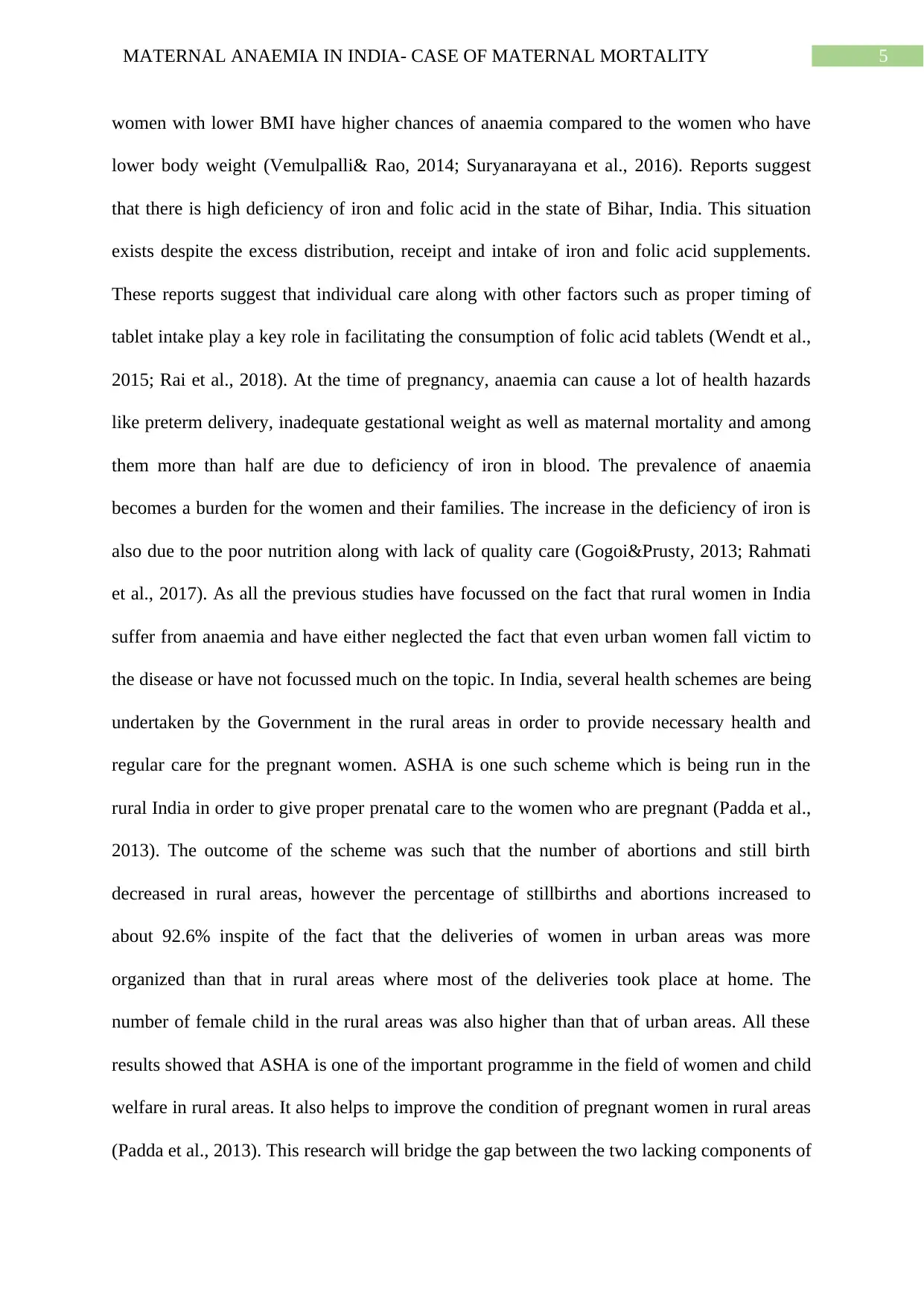
5MATERNAL ANAEMIA IN INDIA- CASE OF MATERNAL MORTALITY
women with lower BMI have higher chances of anaemia compared to the women who have
lower body weight (Vemulpalli& Rao, 2014; Suryanarayana et al., 2016). Reports suggest
that there is high deficiency of iron and folic acid in the state of Bihar, India. This situation
exists despite the excess distribution, receipt and intake of iron and folic acid supplements.
These reports suggest that individual care along with other factors such as proper timing of
tablet intake play a key role in facilitating the consumption of folic acid tablets (Wendt et al.,
2015; Rai et al., 2018). At the time of pregnancy, anaemia can cause a lot of health hazards
like preterm delivery, inadequate gestational weight as well as maternal mortality and among
them more than half are due to deficiency of iron in blood. The prevalence of anaemia
becomes a burden for the women and their families. The increase in the deficiency of iron is
also due to the poor nutrition along with lack of quality care (Gogoi&Prusty, 2013; Rahmati
et al., 2017). As all the previous studies have focussed on the fact that rural women in India
suffer from anaemia and have either neglected the fact that even urban women fall victim to
the disease or have not focussed much on the topic. In India, several health schemes are being
undertaken by the Government in the rural areas in order to provide necessary health and
regular care for the pregnant women. ASHA is one such scheme which is being run in the
rural India in order to give proper prenatal care to the women who are pregnant (Padda et al.,
2013). The outcome of the scheme was such that the number of abortions and still birth
decreased in rural areas, however the percentage of stillbirths and abortions increased to
about 92.6% inspite of the fact that the deliveries of women in urban areas was more
organized than that in rural areas where most of the deliveries took place at home. The
number of female child in the rural areas was also higher than that of urban areas. All these
results showed that ASHA is one of the important programme in the field of women and child
welfare in rural areas. It also helps to improve the condition of pregnant women in rural areas
(Padda et al., 2013). This research will bridge the gap between the two lacking components of
women with lower BMI have higher chances of anaemia compared to the women who have
lower body weight (Vemulpalli& Rao, 2014; Suryanarayana et al., 2016). Reports suggest
that there is high deficiency of iron and folic acid in the state of Bihar, India. This situation
exists despite the excess distribution, receipt and intake of iron and folic acid supplements.
These reports suggest that individual care along with other factors such as proper timing of
tablet intake play a key role in facilitating the consumption of folic acid tablets (Wendt et al.,
2015; Rai et al., 2018). At the time of pregnancy, anaemia can cause a lot of health hazards
like preterm delivery, inadequate gestational weight as well as maternal mortality and among
them more than half are due to deficiency of iron in blood. The prevalence of anaemia
becomes a burden for the women and their families. The increase in the deficiency of iron is
also due to the poor nutrition along with lack of quality care (Gogoi&Prusty, 2013; Rahmati
et al., 2017). As all the previous studies have focussed on the fact that rural women in India
suffer from anaemia and have either neglected the fact that even urban women fall victim to
the disease or have not focussed much on the topic. In India, several health schemes are being
undertaken by the Government in the rural areas in order to provide necessary health and
regular care for the pregnant women. ASHA is one such scheme which is being run in the
rural India in order to give proper prenatal care to the women who are pregnant (Padda et al.,
2013). The outcome of the scheme was such that the number of abortions and still birth
decreased in rural areas, however the percentage of stillbirths and abortions increased to
about 92.6% inspite of the fact that the deliveries of women in urban areas was more
organized than that in rural areas where most of the deliveries took place at home. The
number of female child in the rural areas was also higher than that of urban areas. All these
results showed that ASHA is one of the important programme in the field of women and child
welfare in rural areas. It also helps to improve the condition of pregnant women in rural areas
(Padda et al., 2013). This research will bridge the gap between the two lacking components of
⊘ This is a preview!⊘
Do you want full access?
Subscribe today to unlock all pages.

Trusted by 1+ million students worldwide

6MATERNAL ANAEMIA IN INDIA- CASE OF MATERNAL MORTALITY
all previous research. In the proposed research study the theory of maternal anaemia in urban
women will be incorporated. In the urban cities of India, despite better infrastructure and
better clinical facility more women are falling prey to maternal anaemia. These outcomes
suggest that the previous statistics are not flexible and thus should be reviewed. There should
be schemes and care programmes for mothers and pregnant women in urban areas so that the
ever increasing rate of maternal anaemia along with stillbirths and abortions are reduced to
minimal.
There is the need to study the rate of maternal anaemia in India because of high
prevalence of iron deficiency in mothers and children in various states and villages of India.
Along with health behaviour there are certain other social demographic factors such
residence, age, education, household and wealth (Gogoi&Prusty, 2013; Rauf et al., 2013).
Previous studies has well explained all the factors that cause maternal anaemia in India but
there is certainly a gap in the literature. All the previous studies have very significantly
highlighted the rates of anaemia in various rural states of India as well as the high rate of
intake of folic acid and iron supplements, but still they do not highlight the prevalence of
anaemia in pregnant women in the urban cities of India as well as the circumstances that they
have to face during maternal anaemia. There is also very less research done on the coping
mechanisms of maternal anaemia in women who reside in the metropolitan cities of
developing India. This research proposal will focus on these concerns of the modern women
in modern India. There is also association of social inequalities with that of maternal
anaemia. There are a number of social atrocities linked to that of maternal anaemia in India.
A number of small scale epidemiological studies has been done on the women population by
the National Family Health Surveys (NFHS) and District Level Household and Facility
Surveys (DLHS). These studies has been useful in determining the burden of maternal
anaemia in India. These studies show that the social pattern of maternal anaemia across the
all previous research. In the proposed research study the theory of maternal anaemia in urban
women will be incorporated. In the urban cities of India, despite better infrastructure and
better clinical facility more women are falling prey to maternal anaemia. These outcomes
suggest that the previous statistics are not flexible and thus should be reviewed. There should
be schemes and care programmes for mothers and pregnant women in urban areas so that the
ever increasing rate of maternal anaemia along with stillbirths and abortions are reduced to
minimal.
There is the need to study the rate of maternal anaemia in India because of high
prevalence of iron deficiency in mothers and children in various states and villages of India.
Along with health behaviour there are certain other social demographic factors such
residence, age, education, household and wealth (Gogoi&Prusty, 2013; Rauf et al., 2013).
Previous studies has well explained all the factors that cause maternal anaemia in India but
there is certainly a gap in the literature. All the previous studies have very significantly
highlighted the rates of anaemia in various rural states of India as well as the high rate of
intake of folic acid and iron supplements, but still they do not highlight the prevalence of
anaemia in pregnant women in the urban cities of India as well as the circumstances that they
have to face during maternal anaemia. There is also very less research done on the coping
mechanisms of maternal anaemia in women who reside in the metropolitan cities of
developing India. This research proposal will focus on these concerns of the modern women
in modern India. There is also association of social inequalities with that of maternal
anaemia. There are a number of social atrocities linked to that of maternal anaemia in India.
A number of small scale epidemiological studies has been done on the women population by
the National Family Health Surveys (NFHS) and District Level Household and Facility
Surveys (DLHS). These studies has been useful in determining the burden of maternal
anaemia in India. These studies show that the social pattern of maternal anaemia across the
Paraphrase This Document
Need a fresh take? Get an instant paraphrase of this document with our AI Paraphraser
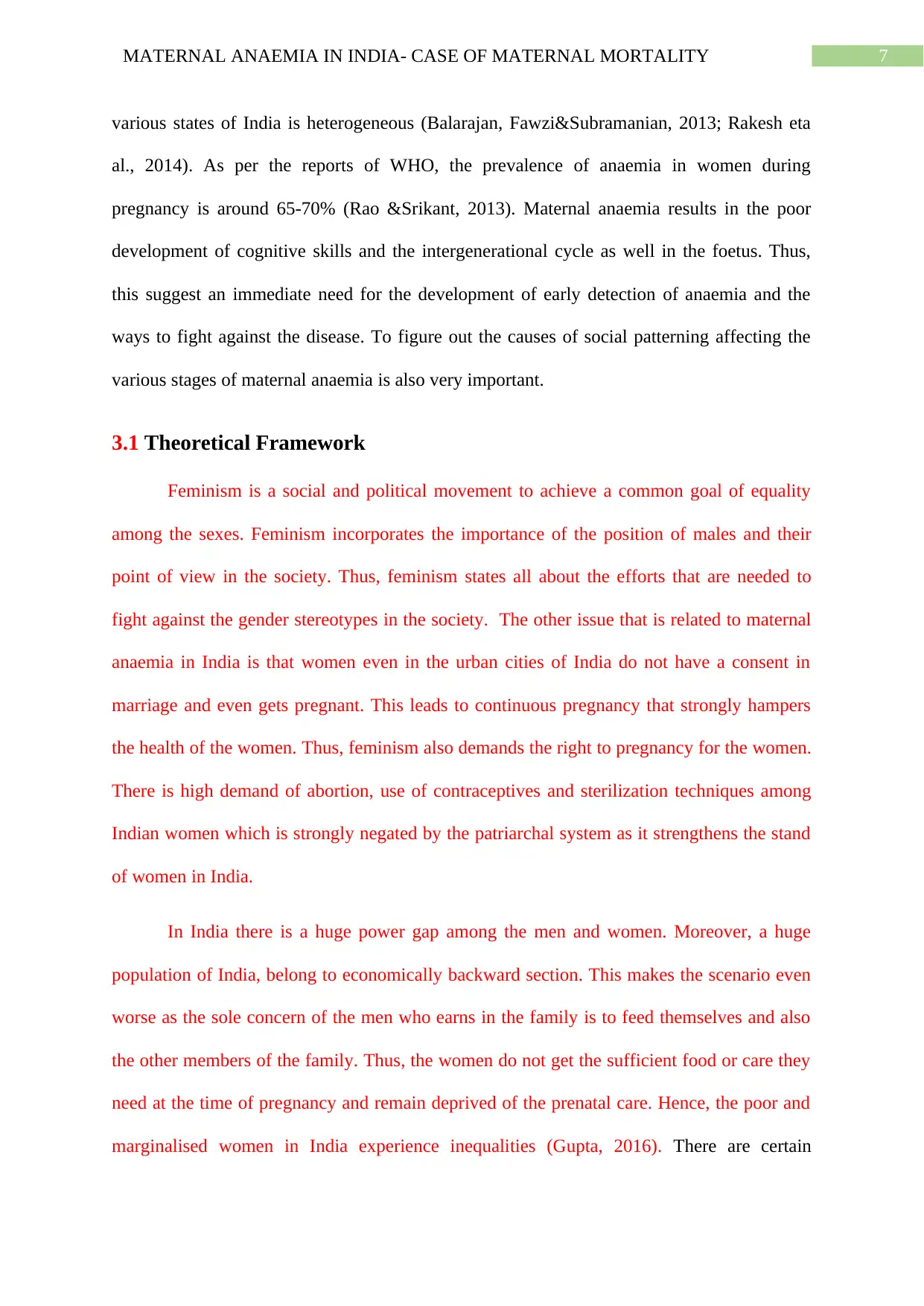
7MATERNAL ANAEMIA IN INDIA- CASE OF MATERNAL MORTALITY
various states of India is heterogeneous (Balarajan, Fawzi&Subramanian, 2013; Rakesh eta
al., 2014). As per the reports of WHO, the prevalence of anaemia in women during
pregnancy is around 65-70% (Rao &Srikant, 2013). Maternal anaemia results in the poor
development of cognitive skills and the intergenerational cycle as well in the foetus. Thus,
this suggest an immediate need for the development of early detection of anaemia and the
ways to fight against the disease. To figure out the causes of social patterning affecting the
various stages of maternal anaemia is also very important.
3.1 Theoretical Framework
Feminism is a social and political movement to achieve a common goal of equality
among the sexes. Feminism incorporates the importance of the position of males and their
point of view in the society. Thus, feminism states all about the efforts that are needed to
fight against the gender stereotypes in the society. The other issue that is related to maternal
anaemia in India is that women even in the urban cities of India do not have a consent in
marriage and even gets pregnant. This leads to continuous pregnancy that strongly hampers
the health of the women. Thus, feminism also demands the right to pregnancy for the women.
There is high demand of abortion, use of contraceptives and sterilization techniques among
Indian women which is strongly negated by the patriarchal system as it strengthens the stand
of women in India.
In India there is a huge power gap among the men and women. Moreover, a huge
population of India, belong to economically backward section. This makes the scenario even
worse as the sole concern of the men who earns in the family is to feed themselves and also
the other members of the family. Thus, the women do not get the sufficient food or care they
need at the time of pregnancy and remain deprived of the prenatal care. Hence, the poor and
marginalised women in India experience inequalities (Gupta, 2016). There are certain
various states of India is heterogeneous (Balarajan, Fawzi&Subramanian, 2013; Rakesh eta
al., 2014). As per the reports of WHO, the prevalence of anaemia in women during
pregnancy is around 65-70% (Rao &Srikant, 2013). Maternal anaemia results in the poor
development of cognitive skills and the intergenerational cycle as well in the foetus. Thus,
this suggest an immediate need for the development of early detection of anaemia and the
ways to fight against the disease. To figure out the causes of social patterning affecting the
various stages of maternal anaemia is also very important.
3.1 Theoretical Framework
Feminism is a social and political movement to achieve a common goal of equality
among the sexes. Feminism incorporates the importance of the position of males and their
point of view in the society. Thus, feminism states all about the efforts that are needed to
fight against the gender stereotypes in the society. The other issue that is related to maternal
anaemia in India is that women even in the urban cities of India do not have a consent in
marriage and even gets pregnant. This leads to continuous pregnancy that strongly hampers
the health of the women. Thus, feminism also demands the right to pregnancy for the women.
There is high demand of abortion, use of contraceptives and sterilization techniques among
Indian women which is strongly negated by the patriarchal system as it strengthens the stand
of women in India.
In India there is a huge power gap among the men and women. Moreover, a huge
population of India, belong to economically backward section. This makes the scenario even
worse as the sole concern of the men who earns in the family is to feed themselves and also
the other members of the family. Thus, the women do not get the sufficient food or care they
need at the time of pregnancy and remain deprived of the prenatal care. Hence, the poor and
marginalised women in India experience inequalities (Gupta, 2016). There are certain

8MATERNAL ANAEMIA IN INDIA- CASE OF MATERNAL MORTALITY
evidences that link the feminism theory with the research in a way that all the women having
anaemia at the time of pregnancy are examined on the basis of some socio-demographic
factors that affect the cases of anaemia that exist in India. These factors are education,
housing facilities, proper diet and proper sanitation habit (Biswas & Baruah, 2014). These
evidences clearly show that the condition of women in Indian society is deteriorating that
affects their health. There is also a crucial need for the development of various effective
management strategies that will reduce the risk of maternal anaemia.
4. Research Questions
1. What is the percentage of women in the urban cities of India who are suffering
from anaemia at some stage of pregnancy and to compare the lifestyle pattern
differences and similarities?
2. Why is there an acceleration of the maternal anaemia amongst the urban women?
3. What are the ways that can be used by the pregnant women in order to fulfil the
requirement of iron in blood as well as to increase the amount of haemoglobin?
5. Research Aims and Objectives
5.1 Overall Aim
The aim of the research is to highlight the issue of maternal anaemia in women
residing in cities. It will also highlight the main reasons that cause anaemia in urban women
despite of the fact that they have proper education, diet, housing facility along with proper
basic education.
5.2 Specific Objectives
The objectives of this research are:-
evidences that link the feminism theory with the research in a way that all the women having
anaemia at the time of pregnancy are examined on the basis of some socio-demographic
factors that affect the cases of anaemia that exist in India. These factors are education,
housing facilities, proper diet and proper sanitation habit (Biswas & Baruah, 2014). These
evidences clearly show that the condition of women in Indian society is deteriorating that
affects their health. There is also a crucial need for the development of various effective
management strategies that will reduce the risk of maternal anaemia.
4. Research Questions
1. What is the percentage of women in the urban cities of India who are suffering
from anaemia at some stage of pregnancy and to compare the lifestyle pattern
differences and similarities?
2. Why is there an acceleration of the maternal anaemia amongst the urban women?
3. What are the ways that can be used by the pregnant women in order to fulfil the
requirement of iron in blood as well as to increase the amount of haemoglobin?
5. Research Aims and Objectives
5.1 Overall Aim
The aim of the research is to highlight the issue of maternal anaemia in women
residing in cities. It will also highlight the main reasons that cause anaemia in urban women
despite of the fact that they have proper education, diet, housing facility along with proper
basic education.
5.2 Specific Objectives
The objectives of this research are:-
⊘ This is a preview!⊘
Do you want full access?
Subscribe today to unlock all pages.

Trusted by 1+ million students worldwide

9MATERNAL ANAEMIA IN INDIA- CASE OF MATERNAL MORTALITY
1. To highlight the percentage and compare the prevalence of anaemia in urban
women to that of rural women.
2. To find out the reason behind the acceleration of maternal anaemia in urban
women who are either pregnant or have borne child.
3. To recommend alternative ways that will help in overcoming occurrence of
maternal anaemia in women.
6. Research Design
The research will be conducted on the urban women living in metropolitan cities of
India. The criteria used will be that of the definition of anaemia defined by WHO which
states that if the haemoglobin rate in pregnant women is equal to or less than 6.66 mg/dl then
the condition of maternal anaemia is severe (Bansal et al., 2013). There will be an increase in
the demand of plasma volume and the mass of red cell. This imbalance causes haemodilution
ultimately lowering the haemoglobin level (Ivan &Mangaiarkkarasi, 2013).
6.1 Qualitative Research Design
The qualitative research design will focus on the findings from the interview of the
participating women. Qualitative research design will be used because it helps in the in depth
analysis of the particular case study. Thus, interview is done to get the data on the common
qualities as well as the common categories of interests (Gale et al., 2013). The research
participants will include 150 women who fall under the age group of 25-40 years of age and
live in the different parts of the metropolitan cities.
6.3 Research Paradigm
Interpretivism will be the research paradigm that will be used in the research. It will
examine the interview that will be conducted on the participants. This will result in the
integration of human study into the research. As qualitative data collection deals with the data
1. To highlight the percentage and compare the prevalence of anaemia in urban
women to that of rural women.
2. To find out the reason behind the acceleration of maternal anaemia in urban
women who are either pregnant or have borne child.
3. To recommend alternative ways that will help in overcoming occurrence of
maternal anaemia in women.
6. Research Design
The research will be conducted on the urban women living in metropolitan cities of
India. The criteria used will be that of the definition of anaemia defined by WHO which
states that if the haemoglobin rate in pregnant women is equal to or less than 6.66 mg/dl then
the condition of maternal anaemia is severe (Bansal et al., 2013). There will be an increase in
the demand of plasma volume and the mass of red cell. This imbalance causes haemodilution
ultimately lowering the haemoglobin level (Ivan &Mangaiarkkarasi, 2013).
6.1 Qualitative Research Design
The qualitative research design will focus on the findings from the interview of the
participating women. Qualitative research design will be used because it helps in the in depth
analysis of the particular case study. Thus, interview is done to get the data on the common
qualities as well as the common categories of interests (Gale et al., 2013). The research
participants will include 150 women who fall under the age group of 25-40 years of age and
live in the different parts of the metropolitan cities.
6.3 Research Paradigm
Interpretivism will be the research paradigm that will be used in the research. It will
examine the interview that will be conducted on the participants. This will result in the
integration of human study into the research. As qualitative data collection deals with the data
Paraphrase This Document
Need a fresh take? Get an instant paraphrase of this document with our AI Paraphraser
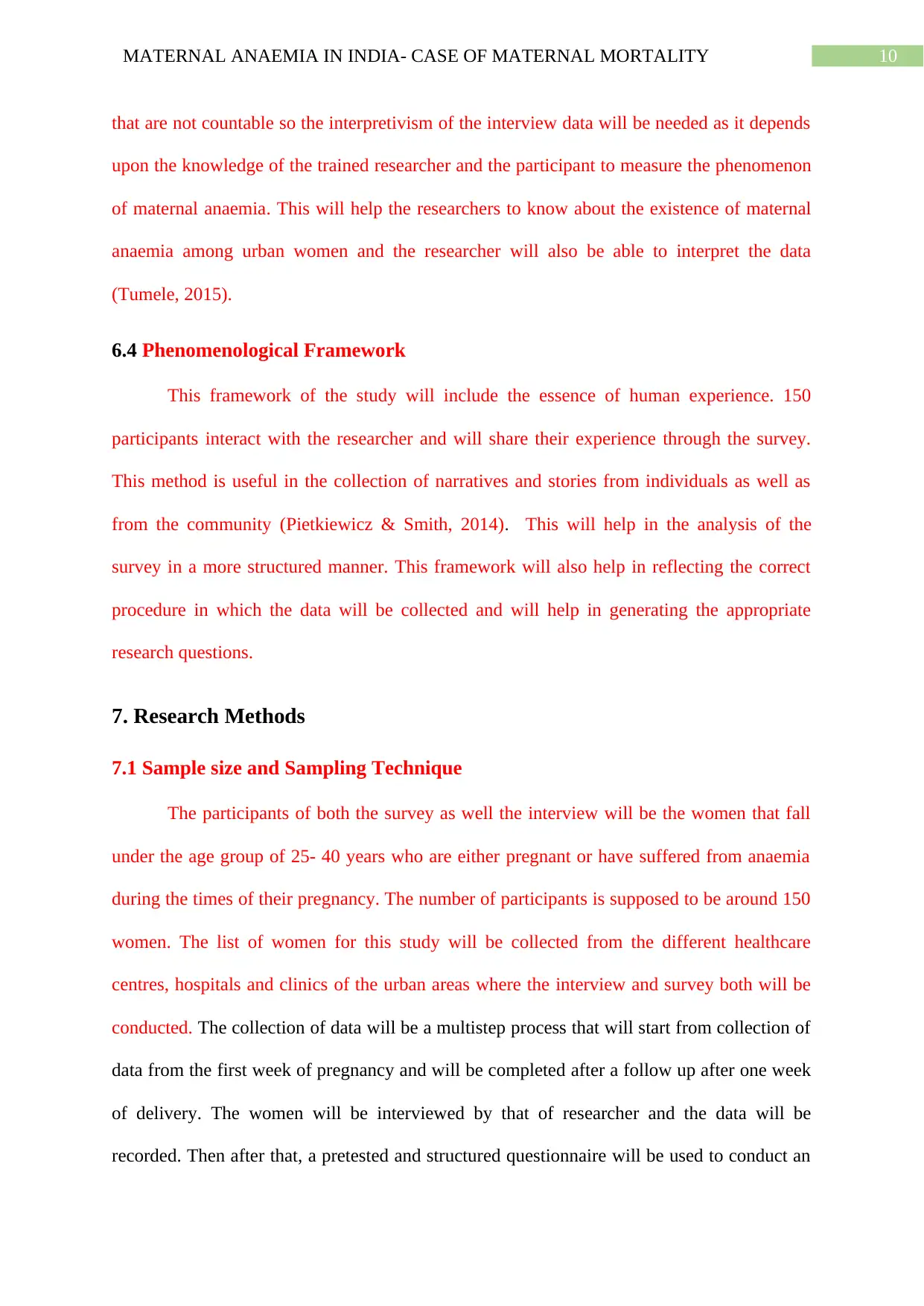
10MATERNAL ANAEMIA IN INDIA- CASE OF MATERNAL MORTALITY
that are not countable so the interpretivism of the interview data will be needed as it depends
upon the knowledge of the trained researcher and the participant to measure the phenomenon
of maternal anaemia. This will help the researchers to know about the existence of maternal
anaemia among urban women and the researcher will also be able to interpret the data
(Tumele, 2015).
6.4 Phenomenological Framework
This framework of the study will include the essence of human experience. 150
participants interact with the researcher and will share their experience through the survey.
This method is useful in the collection of narratives and stories from individuals as well as
from the community (Pietkiewicz & Smith, 2014). This will help in the analysis of the
survey in a more structured manner. This framework will also help in reflecting the correct
procedure in which the data will be collected and will help in generating the appropriate
research questions.
7. Research Methods
7.1 Sample size and Sampling Technique
The participants of both the survey as well the interview will be the women that fall
under the age group of 25- 40 years who are either pregnant or have suffered from anaemia
during the times of their pregnancy. The number of participants is supposed to be around 150
women. The list of women for this study will be collected from the different healthcare
centres, hospitals and clinics of the urban areas where the interview and survey both will be
conducted. The collection of data will be a multistep process that will start from collection of
data from the first week of pregnancy and will be completed after a follow up after one week
of delivery. The women will be interviewed by that of researcher and the data will be
recorded. Then after that, a pretested and structured questionnaire will be used to conduct an
that are not countable so the interpretivism of the interview data will be needed as it depends
upon the knowledge of the trained researcher and the participant to measure the phenomenon
of maternal anaemia. This will help the researchers to know about the existence of maternal
anaemia among urban women and the researcher will also be able to interpret the data
(Tumele, 2015).
6.4 Phenomenological Framework
This framework of the study will include the essence of human experience. 150
participants interact with the researcher and will share their experience through the survey.
This method is useful in the collection of narratives and stories from individuals as well as
from the community (Pietkiewicz & Smith, 2014). This will help in the analysis of the
survey in a more structured manner. This framework will also help in reflecting the correct
procedure in which the data will be collected and will help in generating the appropriate
research questions.
7. Research Methods
7.1 Sample size and Sampling Technique
The participants of both the survey as well the interview will be the women that fall
under the age group of 25- 40 years who are either pregnant or have suffered from anaemia
during the times of their pregnancy. The number of participants is supposed to be around 150
women. The list of women for this study will be collected from the different healthcare
centres, hospitals and clinics of the urban areas where the interview and survey both will be
conducted. The collection of data will be a multistep process that will start from collection of
data from the first week of pregnancy and will be completed after a follow up after one week
of delivery. The women will be interviewed by that of researcher and the data will be
recorded. Then after that, a pretested and structured questionnaire will be used to conduct an
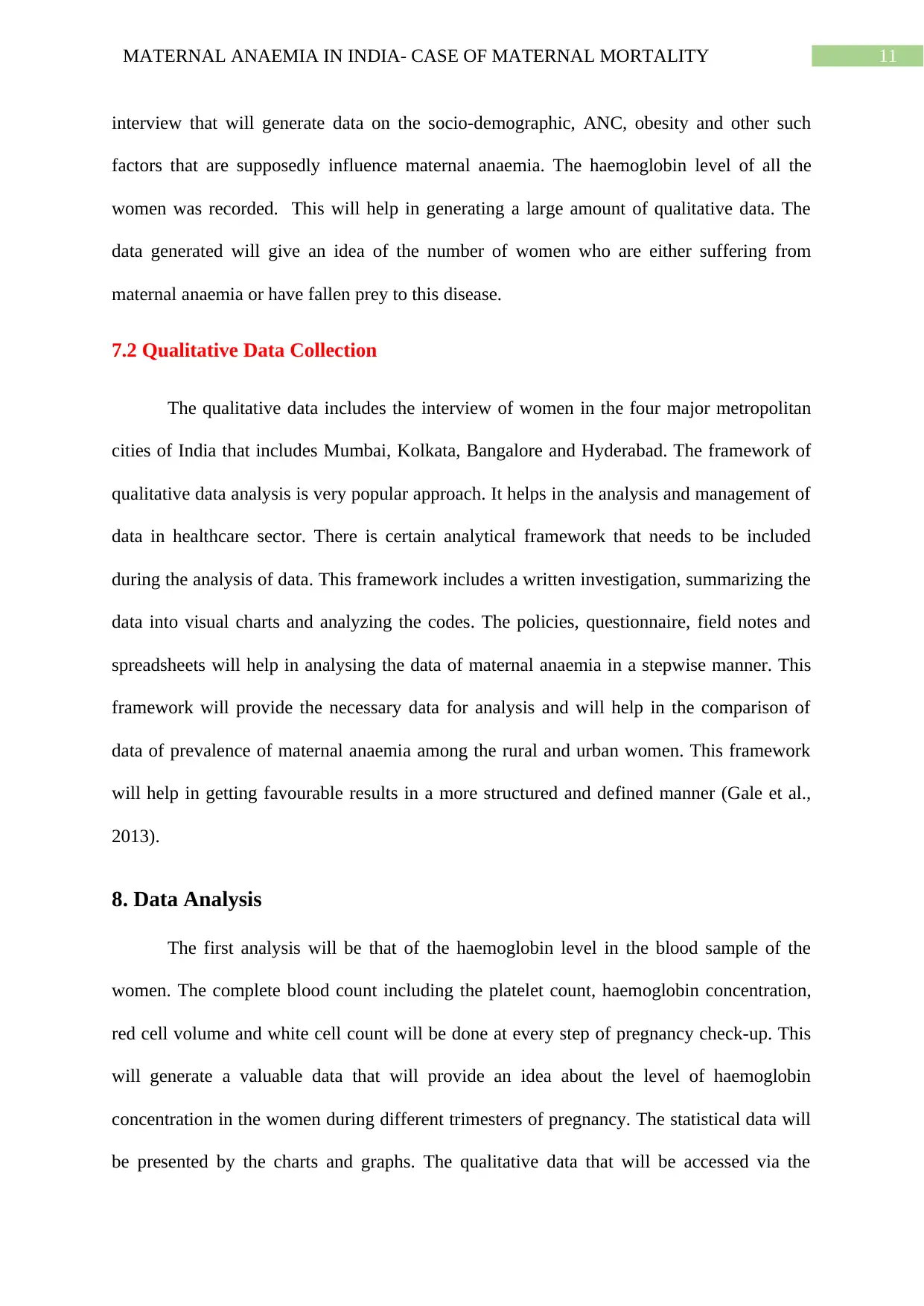
11MATERNAL ANAEMIA IN INDIA- CASE OF MATERNAL MORTALITY
interview that will generate data on the socio-demographic, ANC, obesity and other such
factors that are supposedly influence maternal anaemia. The haemoglobin level of all the
women was recorded. This will help in generating a large amount of qualitative data. The
data generated will give an idea of the number of women who are either suffering from
maternal anaemia or have fallen prey to this disease.
7.2 Qualitative Data Collection
The qualitative data includes the interview of women in the four major metropolitan
cities of India that includes Mumbai, Kolkata, Bangalore and Hyderabad. The framework of
qualitative data analysis is very popular approach. It helps in the analysis and management of
data in healthcare sector. There is certain analytical framework that needs to be included
during the analysis of data. This framework includes a written investigation, summarizing the
data into visual charts and analyzing the codes. The policies, questionnaire, field notes and
spreadsheets will help in analysing the data of maternal anaemia in a stepwise manner. This
framework will provide the necessary data for analysis and will help in the comparison of
data of prevalence of maternal anaemia among the rural and urban women. This framework
will help in getting favourable results in a more structured and defined manner (Gale et al.,
2013).
8. Data Analysis
The first analysis will be that of the haemoglobin level in the blood sample of the
women. The complete blood count including the platelet count, haemoglobin concentration,
red cell volume and white cell count will be done at every step of pregnancy check-up. This
will generate a valuable data that will provide an idea about the level of haemoglobin
concentration in the women during different trimesters of pregnancy. The statistical data will
be presented by the charts and graphs. The qualitative data that will be accessed via the
interview that will generate data on the socio-demographic, ANC, obesity and other such
factors that are supposedly influence maternal anaemia. The haemoglobin level of all the
women was recorded. This will help in generating a large amount of qualitative data. The
data generated will give an idea of the number of women who are either suffering from
maternal anaemia or have fallen prey to this disease.
7.2 Qualitative Data Collection
The qualitative data includes the interview of women in the four major metropolitan
cities of India that includes Mumbai, Kolkata, Bangalore and Hyderabad. The framework of
qualitative data analysis is very popular approach. It helps in the analysis and management of
data in healthcare sector. There is certain analytical framework that needs to be included
during the analysis of data. This framework includes a written investigation, summarizing the
data into visual charts and analyzing the codes. The policies, questionnaire, field notes and
spreadsheets will help in analysing the data of maternal anaemia in a stepwise manner. This
framework will provide the necessary data for analysis and will help in the comparison of
data of prevalence of maternal anaemia among the rural and urban women. This framework
will help in getting favourable results in a more structured and defined manner (Gale et al.,
2013).
8. Data Analysis
The first analysis will be that of the haemoglobin level in the blood sample of the
women. The complete blood count including the platelet count, haemoglobin concentration,
red cell volume and white cell count will be done at every step of pregnancy check-up. This
will generate a valuable data that will provide an idea about the level of haemoglobin
concentration in the women during different trimesters of pregnancy. The statistical data will
be presented by the charts and graphs. The qualitative data that will be accessed via the
⊘ This is a preview!⊘
Do you want full access?
Subscribe today to unlock all pages.

Trusted by 1+ million students worldwide
1 out of 23
Related Documents
Your All-in-One AI-Powered Toolkit for Academic Success.
+13062052269
info@desklib.com
Available 24*7 on WhatsApp / Email
![[object Object]](/_next/static/media/star-bottom.7253800d.svg)
Unlock your academic potential
Copyright © 2020–2025 A2Z Services. All Rights Reserved. Developed and managed by ZUCOL.





